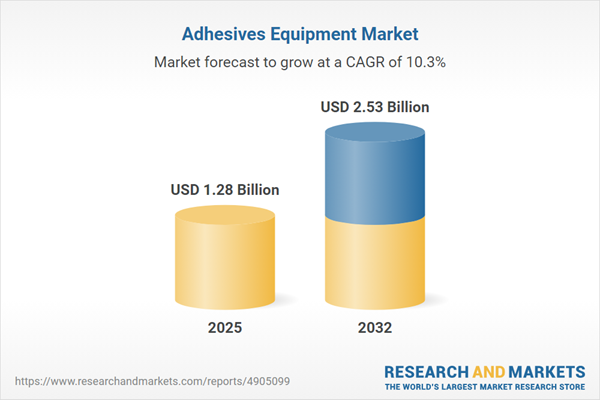Speak directly to the analyst to clarify any post sales queries you may have.
The adhesives equipment market is undergoing significant transformation as manufacturers and senior leadership teams prioritize digital modernization to stay ahead of regulatory shifts and advance operational efficiency.
Market Snapshot: Growth Trajectory in the Adhesives Equipment Market
The adhesives equipment market is projected for notable growth through 2032, propelled by a strong compound annual growth rate and optimistic outlooks from industry stakeholders. Expansion is being driven by persistent demand across automotive, electronics, packaging, construction, woodworking, and medical device industries. Widespread adoption of integrated adhesive systems aids companies in streamlining their operations, responding to regulatory updates, and furthering sustainability objectives. As organizations transition from legacy processes, digital technologies drive change through enhanced control, adaptability, and innovation. Automation and optimized equipment help manufacturers address the increasing complexities in global supply chains and production requirements.
Scope & Segmentation: Strategic Insights for Senior Leadership
This market analysis offers an actionable breakdown, empowering senior executives to optimize resource planning and investment strategies by providing detailed insights into all major segments:
- Product Types: Bonding machines—including hot melt and cold glue variants—coating systems for a range of substrates, dispensing equipment from manual to automated, mixing solutions for specialized adhesive formulations, and high-precision spraying systems that suit various industry applications.
- Technologies: Systems based on hot melt adhesive platforms, reactive adhesive equipment for challenging production settings, sustainable solvent-based and water-based machinery, and UV-cure options (LED or arc) engineered for strict compliance.
- Sales Channels: Aftermarket solutions for fast spare parts and support alongside OEM partnerships, helping maximize equipment lifespan and minimize downtime.
- Applications: Assembly, lamination, flexible packaging, taping, masking, and sealing—each aligned with industry needs for high performance and quality control.
- End-Use Industries: Continuously evolving requirements across medical devices, automotive, electronics, construction, packaging, and woodworking sectors, all relying on precise and compliant equipment.
- Regions: Comprehensive geographical coverage in the Americas, EMEA, and Asia-Pacific, featuring insights into technology adoption, local regulatory changes, and market dynamics to guide global strategies.
- Leading Companies: In-depth profiles of Nordson Corporation, Graco Inc., Illinois Tool Works Inc., The Dover Corporation, Robatech AG, SAMES KREMLIN SAS, Techcon Systems, Axson Technologies, Valco Cincinnati, and Glue Machinery Corporation, highlighting their technical capabilities and diversified market presence.
Key Takeaways for Senior Decision-Makers
- Digitally enabled adhesives equipment supports real-time diagnostics and predictive asset management, allowing senior executives to effectively oversee diverse production sites and optimize resource deployment.
- Compliance-ready and sustainability-focused technology platforms enable organizations to respond rapidly to stringent regulations, safeguarding operational continuity under evolving global mandates.
- Flexible, modular, and reconfigurable equipment solutions accelerate time-to-market for new products and allow organizations to pivot quickly in response to shifting customer needs.
- Robust aftermarket support is essential for maintaining production reliability, directly impacting profitability and supporting uninterrupted manufacturing operations.
- Expanding regional manufacturing capabilities and developing strategic supplier partnerships strengthen global supply chain resilience, positioning organizations to manage potential disruptions in trade or logistics.
Tariff Impact: Navigating Changing U.S. Trade Policy
Recent U.S. tariff adjustments for adhesives equipment have prompted companies to update supply chain approaches. Leading organizations are increasing domestic production, forging closer connections with local suppliers, and enhancing compliance practices. Larger enterprise players rely on adaptable infrastructure to mitigate cost or operational shifts, while smaller businesses emphasize strong supplier relationships for greater responsiveness in dynamic trade conditions.
Methodology & Data Sources
This report integrates executive-level interviews with rigorously validated secondary research. Insights undergo systematic triangulation, ensuring the intelligence delivered is reliable and meets the strategic requirements of high-level planning and decision-making.
Why This Report Matters
- Equips senior leaders to review emerging adhesives equipment technologies and adopt scalable digital solutions for manufacturing efficiency.
- Clarifies both market and regulatory developments so organizations can proactively address industry change and uphold compliance in evolving environments.
- Delivers actionable intelligence for agile and risk-resilient planning, supporting rapid responses to market shifts and changing stakeholder expectations.
Conclusion
Investing in advanced adhesives equipment and ongoing digital transformation underpins both agility and compliance. Senior executives can leverage these findings to inform strategy, prioritize investments, and successfully adapt to ongoing industry changes.
Additional Product Information:
- Purchase of this report includes 1 year online access with quarterly updates.
- This report can be updated on request. Please contact our Customer Experience team using the Ask a Question widget on our website.
Table of Contents
3. Executive Summary
4. Market Overview
7. Cumulative Impact of Artificial Intelligence 2025
Companies Mentioned
The companies profiled in this Adhesives Equipment market report include:- Nordson Corporation
- Graco Inc.
- Illinois Tool Works Inc.
- The Dover Corporation
- Robatech AG
- SAMES KREMLIN SAS
- Techcon Systems, Inc.
- Axson Technologies, Inc.
- Valco Cincinnati, Inc.
- Glue Machinery Corporation
Table Information
| Report Attribute | Details |
|---|---|
| No. of Pages | 193 |
| Published | October 2025 |
| Forecast Period | 2025 - 2032 |
| Estimated Market Value ( USD | $ 1.28 Billion |
| Forecasted Market Value ( USD | $ 2.53 Billion |
| Compound Annual Growth Rate | 10.2% |
| Regions Covered | Global |
| No. of Companies Mentioned | 11 |









